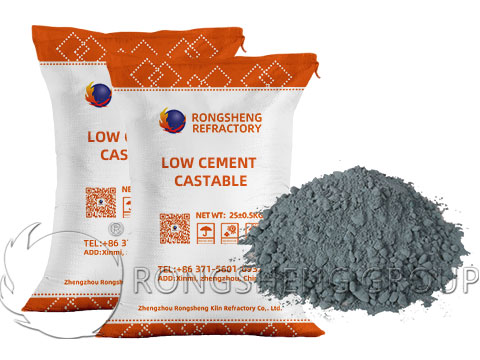A heat treatment furnace is a general term for industrial furnaces that perform various metal heating processes on metal workpieces. The temperature is generally lower than that of the heating furnace. The heat treatment furnace can use various furnace types, but it is relatively strict to control the furnace temperature and the atmosphere in the furnace. Heat treatment furnaces are mostly heated using gaseous fuels. In order to accurately control the furnace temperature, some heat treatment furnaces use electric heating. The solution of refractory materials for heat treatment furnaces is not difficult to achieve.
The overall structure of the heat treatment furnace is composed of three parts: furnace wall, furnace top, and furnace bottom. Refractory bricks, refractory castables, and refractory fiber cotton are generally used as furnace linings. Due to the different furnace types, refractory types, and heat treatment process conditions, the service life is also different. The masonry of the refractory material should be constructed in accordance with the design scheme of the furnace, so as to achieve the tightness of the use of the entire kiln, the rationalization of the structure, and the prolongation of the furnace age.
Refractory Bricks Furnace Body
There are many types of furnaces that are often used in heat treatment furnaces. The heat treatment furnace has a low construction temperature and good operating conditions. Generally, it is built with heat-insulating refractory bricks or clay refractory bricks. Individual parts use high alumina refractory bricks, cordierite bricks, silicon carbide bricks, corundum bricks, etc., and can also use amorphous refractory materials as linings.

Furnace linings built with insulating refractory bricks and refractory bricks are suitable for various heat treatment furnaces. The thickness of the furnace wall is generally about 460mm. The thickness of the thermal insulation layer is 70~230mm. Use diatomite refractory bricks with a bulk density of 0.8g/cm3, clay or high-alumina insulation bricks, floating bead bricks, or calcium silicate insulation boards. The thickness of the working layer is 230~348mm.
The working layers of high-temperature annealing furnaces such as chain furnaces and muffle furnaces are built with clay refractory bricks. The working layers of continuous horizontal furnaces, tower furnaces, and bell furnaces can be built with clay or high alumina insulating bricks and floating bead bricks with a bulk density of 0.8~1.0g/cm3. The masonry on the upper side of the rollers of the roller hearth furnace is built with roller neck bricks to facilitate the replacement of the furnace rollers. The furnace walls of tower furnaces and pit furnaces are relatively high. In order to prevent all pouring out, metal joists or tensile bricks should be installed every 2m high and connected to the furnace shell. The holes in the furnace wall are all built with clay refractory bricks.
The furnace roof is divided into hanging flat roofs, fixed or detachable vaults, and so on. The furnace roof of a pit furnace or the like is a movable furnace cover. The thickness of the furnace top working layer and the thermal insulation layer is 230mm and 70~230mm respectively. The refractory material used is basically the same as that of the furnace wall.
The bottom of the heat treatment furnace, except for the catenary furnace and some muffle furnaces, is load-bearing. The thickness of the working layer and the thermal insulation layer is generally 230mm and 70~230mm respectively. The former is built with clay refractory bricks, while the latter is built with clay or high-alumina insulating bricks, bead bricks, or diatomite bricks. The brick furnace body of the heat treatment furnace can be used for 3 years under proper working conditions, and some can reach more than 4 years. During this period, the vulnerable area liners were subject to several minor repairs.
Refractory Castable Furnace Body
The working layer lining of the heat treatment furnace is cast with refractory castables or suspended with its prefabricated blocks. The furnace bodies of chamber furnaces and car bottom furnaces are hung with refractory castable prefabricated blocks, which not only have a fast construction speed but also have less heat dissipation of the furnace body and have a service life of 3 years. When using anchor bricks and hanging bricks, and using clay refractory castables or high-strength lightweight refractory castables for on-site construction, the furnace body has good integrity, less heat dissipation, and good thermal shock resistance. Therefore, its use is generally 2 years.

Now refractory castables are used more in large heating furnaces. Mostly choose low-cement refractory castables, and use them after adding water and distributing them during construction. Regarding the heating furnace, the thickness of the castable lining is generally 300mm. The operating temperature of low-cement castables and ultra-low cement castables is higher than that of general refractory castables of the same material. Clay and high alumina low cement castables can be used for the lining of various heat treatment furnaces such as heating furnaces and soaking furnaces.
Refractory Fiber Furnace Body
Using refractory fiber blankets, felts, boards, bricks, and their combined blocks to lay the heat treatment furnace body or paste its working layer can save fuel, and the economic benefits are relatively significant. But its performance needs to be improved.
Refractories for Other Parts
Refractory materials for other parts refer to refractory materials for muffle covers, burner bricks, combustion chambers, flues, and chimneys. Bell furnaces and muffle furnaces are indirect heating heat treatment furnaces. The outer hood of the bell furnace is lined with refractory materials, and the inner hood is constructed of heat-resistant steel. Muffle furnaces are generally made of clay bricks to make muffle covers, and some are made of heat-resistant steel.
Rongsheng Refractory can provide the refractory materials required for burner bricks, combustion chambers, flues, and chimneys for heat treatment furnaces. Please contact us to purchase refractories for various industrial furnace linings, including refractories for heating furnaces. We will provide you with high-quality refractory lining materials according to your specific working conditions and production needs.









